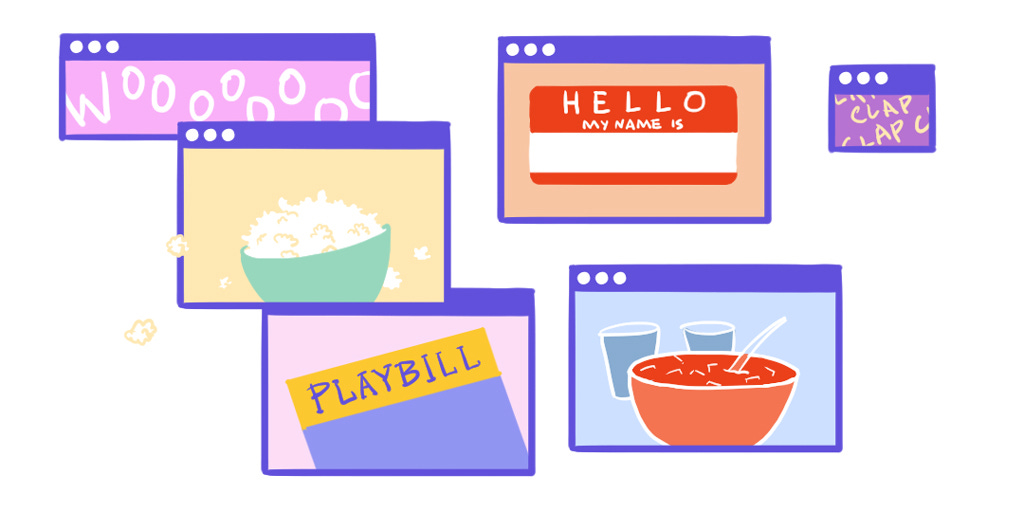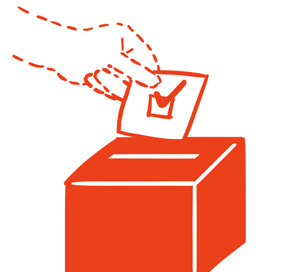Welcome to Civic Signals, where campaigning meets Zoom moderation.
This Week: An all-politics edition! The Biden-Harris ticket is locked ahead of this week’s national conventions. Campaigning mostly moves on-screen. And we want to hear about the best digital spaces you’ve journeyed to during the pandemic. First up: Can our current reliance on various types of peer support networks strengthen our civic connections and help counteract the attacks on our election infrastructure?
Keywords: Absentee
n. A person who is expected or required to be present at a place or event but is not.

While “absentee” is often used specifically to refer to voting by mail when you can’t vote in person, it also applies to much of our current circumstances in this pandemic. Most of us are absent from places and events we love — sports, graduations, birthdays, you name it. And as Jia Tolentino recently wrote, “everything circles a bewildering paradox: other people are both a threat and a lifeline. Physical connection could kill us, but civic connection is the only way to survive”.
While there has always been absentee voting, and states like Oregon have embraced it for decades, it's never been planned for on this scale. The New York Times recently calculated that an astounding 76% of Americans *should* be able to vote by mail in November, with 21% being directly mailed a ballot.
But are these changes temporary, or permanent? There are a lot of complicating factors — the fight over the preservation of the USPS and access to polling locations to name a couple — but there’s a chance that we may look back at this election one day as an inflection point for voting rights, potentially paving the way for measures that many have been advocating for since long before the pandemic: expanding universal “vote by mail”, automatic voter registration and maybe even making Election Day a national holiday.
What’s Clicking
🌐 Online
TikTok collected users’ MAC addresses, a tactic banned by Google. — The Wall Street Journal
Wikipedia decided to stop calling Fox a “reliable” source, in a move that could prove a new model for platform moderation. — WIRED
The global internet has always been fractured. — The New York Times
🏙 Offline
Wondering how the virus spreads around the subway? Wonder no longer. — The New York Times
White Supremacists made Charlottesville a symbol of racism. Black residents say it still is. — The Washington Post
Black Lives Matter murals have been popping up across Los Angeles. Public art, as shown through augmented reality. — The Los Angeles Times
🔗 Linked
Back to school? Look out for Covid-tracking surveillance tech. — The Wall Street Journal
Is QAnon the most dangerous conspiracy theory of the 21st century? — The New York Times
How do you become the world’s choice for a protest app? Ask Jorge Ríos, the CEO and co-founder of Bridgefy. — Rest of World
☞ This Week’s (Double) Double Click
Donald Trump and the COVID-19 pandemic are all-consuming topics in the news. But what happens to the coverage of … everything else? One potential solution: create a citizens’ agenda and make that the blueprint for your org’s news coverage. — The Atlantic and WBEZ
Meeting Voters Where They Are
According to Politico, the Trump campaign is knocking on one million doors a week. (!) The Biden camp, which recently pulled their plans for accepting the nomination in person this week in Milwaukee? Zero.
The coronavirus has presented some difficult logistical challenges that fly in the face of traditional campaigning. How do you “get out the vote” when you can't safely go door-to-door and most people don’t know who you are?


The answer may be in the fundamental differences between mobilizing and organizing. In March, Vox’s Ezra Klein invited scholar, writer and organizer Jane McAlevey onto his podcast to discuss the issue.
As Klein wrote, “To McAlevey, organizing, at its core, is about something very simple and very close to the heart of this show: How do you talk to people who may not agree with you such that you can truly hear them, and they can truly hear you?” In other words, how can you make strangers less strange?
While their conversation is mostly concerned with how those on the left have organized for political power, it’s taken on a new resonance now as the two parties gear up for the final sprint to Election Day — one in a remote, pandemic world, and the other not at all.

And not every Democratic candidate has the benefit of having been the vice president. Hundreds of first-time candidates around the country are having to invent new practices for reaching voters, including handwritten notes, Facebook virtual offices and virtual town halls. Jamaal Bowman, an educator who beat 16-term incumbent House Rep. Eliot Engel in New York, established a robust phone-banking network that first connected residents with mutual-aid before stumping for Bowman. Ed Markey picked up on the same thread at the close of this rollicking ad, saying: “With all due respect, it’s time to start asking what your country can do for you”.
This idea, that the conversation with a voter should begin with something besides a stranger asking for your vote, is core to the idea of relational organizing. If coworkers reaching out to coworkers and friends talking to friends sounds familiar, that’s because it has a lot in common with the way our society has been sorting into quarantine bubbles and pods. And whether you’re talking virtual politicking or a library-organized local knitting circle, these gatherings of friends and acquaintances are likely occurring over Zoom. As evidenced in this anecdote from a Bowman event, the norms and best practices are evolving in public, one group at a time:
Some parts took longer to come together than others. “Tonia, could you put yourself on mute?” Bowman asked one participant in a Yonkers “town hall” after a dog barked over half a minute of his stump speech. The barking quieted, and attendees soon saw a small white terrier jump into one of the video panels lining the top of the Zoom screen. Another town hall was interrupted by Bowman’s 6-year-old daughter, who ran into his home office to show off a missing tooth.
Meanwhile, the first ever all-virtual DNC kicks off tomorrow. Can pre-recorded videos and crowd-less speeches directly addressing the camera actually rally the base and motivate fence-sitting voters?
Digital ops teams are counting on a suite of engagement tactics, the enthusiasm of self-appointed social surrogates and perhaps the fact that people sitting at home are eager to be heard in some way.
Make It Digital: Humanizing Virtual Experiences

For #MakeItDigital this week, we’re going back to basics. Our question for you: What experiences have you had in the digital sphere — whether a social event, a conference, theater, etc. — that have been meaningful, engaging and especially suited to a digital environment? In short, what virtually native events have you attended that have been social and cultural gatherings in their own right — not just the remote replacement for a physical occasion that can’t happen?
We’d love to hear your thoughts. Send us your ideas at civic.signals@gmail.com or @ us using #MakeItDigital on Twitter or Instagram.
💻 On social: See what we’re up to on Twitter, Instagram and LinkedIn as we get ready to share some exciting new initiatives.
📝 Do you have 10min to spare? Why not take our survey!
Sending our ballots back on the first day we can,
The Civic Signals Team
Illustrations by Josh Kramer
Civic Signals is a partnership between the Center for Media Engagement at the University of Texas, Austin and the National Conference on Citizenship, and was incubated by New America. Please share this newsletter with your friends!



